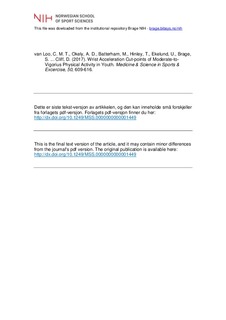| dc.description.abstract | Purpose: To examine the validity of wrist acceleration cut-points for classifying moderate (MPA), vigorous (VPA) and moderate-to-vigorous (MVPA) physical activity. Methods: Fifty-seven children (5-12y) completed 15 semi-structured activities. Three sets of wrist cutpoints (>192mg, >250mg, >314mg), previously developed using Euclidian norm minus one (ENMO192+), GENEActiv software (GENEA250+) and Bandpass Filtered followed by Euclidian Norm (BFEN314+), were evaluated against indirect calorimetry. Analyses included classification accuracy, equivalence testing and Bland-Altman procedures. Results: All cut-points classified MPA, VPA and MVPA with substantial accuracy (ENMO192+: κ = 0.72 [95% confidence interval: 0.72 – 0.73], MVPA: area under the receiver operating characteristic curve (ROC-AUC) = 0.85 [0.85 – 0.86]; GENEA250+: κ = 0.75 [0.74 – 0.76], MVPA: ROC-AUC = 0.85 [0.85 – 0.86]; BFEN314+: κ = 0.73 [0.72 – 0.74], MVPA: ROC-AUC = 0.86 [0.86 – 0.87]). BFEN314+ misclassified 19.7% non-MVPA epochs as MPA, whereas ENMO192+ and GENEA250+ misclassified 32.6% and 26.5% of MPA epochs as non-MVPA, respectively. Group estimates of MPA time were equivalent (p<0.01) to indirect calorimetry for the BFEN314+ MPA cut-point (mean bias: -1.5%, limits of agreement [LoA]: -57.5 - 60.6%), while estimates of MVPA time were equivalent (p<0.01) to indirect calorimetry for the ENMO192+ (mean bias: -1.1% [LoA: - 53.7% – 55.9%]) and GENEA250+ (mean bias: 2.2% [LoA: -56.5% – 52.2%]) cut-points. Individual variability (LoAs) was large for MPA (min: BFEN314+, -60.6% – 57.5%; max: GENEA250+, -42.0% – 104.1%), VPA (min: BFEN314+, -238.9% – 54.6%; max: ENMO192+, - 244.5% – 127.4%) and MVPA (min: ENMO192+, -53.7% – 55.0%; max: BFEN314+, -83.9% – 25.3%). Conclusion: Wrist acceleration cut-points misclassified a considerable proportion of non-MVPA and MVPA. Group level estimates of MVPA were acceptable; however, error for individual level prediction was larger. | |
